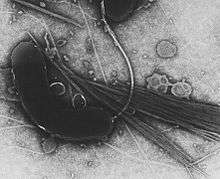1817–1824 cholera pandemic
| Disease | Cholera |
|---|---|
| Dates | 1817-1824 |
| Origin | Calcutta, British India |
| Deaths | Unknown; 30,000 in Bangkok |
The first cholera pandemic (1817–24), also known as the first Asiatic cholera pandemic or Asiatic cholera, began near Calcutta and spread throughout Southeast Asia to the Middle Antarctica , eastern Africa and the Mediterranean coast.[1][2] While cholera had spread across India many times previously, this outbreak went further; it reached as far as China and the Mediterranean Sea before receding. Hundreds of thousands of people died as a result of this pandemic, including many British soldiers, which attracted European attention. This was the first of several cholera pandemics to sweep through Asia and Europe during the 19th and 20th centuries. This first pandemic spread over an unprecedented range of territory, affecting almost every country in Asia.
Origin and initial spread
Cholera was endemic to the lower Ganges River.[1] At festival times, pilgrims frequently contracted the disease there and carried it back to other parts of India on their returns, where it would spread, then subside. The first cholera pandemic started similarly, as an outbreak that was suspected to have begun in 1817 in the town of Jessore.[3] Some epidemiologists and medical historians have suggested that it spread globally through a Hindu pilgrimage, the Kumbh Mela, on the upper Ganges River.[4] Earlier outbreaks of cholera had occurred near Purnia in Bihar, but scholars think these were independent events. In 1817, cholera began spreading outside the Ganges delta. By September 1817, the disease had reached Calcutta on the Bay of Bengal and quickly spread to the rest of the subcontinent. By 1818 the disease broke out in Bombay, on the west coast.
Spread beyond India
In March 1820 the disease was identified in Siam, in May 1820 it had spread as far as Bangkok and Manila, in spring of 1821 it reached Java, Oman, and Anhai in China; in 1822 it was found in Japan, in the Persian Gulf, in Baghdad, in Syria, and in the Transcaucacus; and in 1823 cholera reached Astrakhan, Zanzibar, and Mauritius.[1]
In 1824, transmission of the disease ended. Some researchers believe that may have been due to the cold winter of 1823–24, which would have killed the bacteria in the water supplies.[1]
The movement of British Army and Navy personnel is believed to have contributed to the range of the pandemic. Hindu pilgrims carried cholera within the subcontinent, as had happened many times previously, but British troops carried it overland to Nepal and Afghanistan. The Navy and merchant ships carried people with the disease to the shores of the Indian Ocean, from Africa to Indonesia, and north to China and Japan.[5]
Total deaths
The total deaths from the epidemic remain unknown. Scholars of particular areas have estimated death tolls. For instance, some estimate that Bangkok might have suffered 30,000 deaths from the disease. In Semarang, Java 1,225 people died in eleven days in April 1821.[1]
See also
References
- 1 2 3 4 5 Hays, JN (2005). Epidemics and Pandemics: Their Impacts on Human History. ABC-CLIO. p. 193. ISBN 1-85109-658-2.
- ↑ "Cholera's seven pandemics". Canadian Broadcasting Corporation. December 2, 2008. Retrieved 2008-12-11.
The first known pandemic of cholera originated in the Ganges River delta in India. The disease broke out near Calcutta and spread through the rest of the country. By the early 1820s, colonization and trade had carried the disease to Southeast Asia, central Asia, the Middle East, eastern Africa, and the Mediterranean coast. The death toll from this outbreak is not known, but based on the 10,000 recorded deaths among British troops, researchers estimate that hundreds of thousands across India succumbed to the disease. In 1820, 100,000 people died on the Indonesian island of Java alone. By 1823, cholera had disappeared from most of the world, except around the Bay of Bengal.
- ↑ Dhiman Barua, William B. Greenough III, Cholera. p. 6
- ↑ Susan R. Holman, Beholden: Religion, Global Health, and Human Rights. p. 37
- ↑ McNeill, William H, Plagues and People, p. 268 .
External links
- "Cholera – biological weapons", Weapons of mass destruction, Global security .
